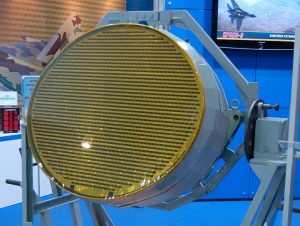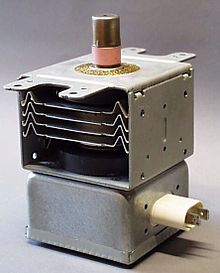Slot Waveguide
The model analyses the mode propagation within a nano slot waveguide. In a slot waveguide configuration, two high refractive index slabs (~3.48) are placed adjacent to the low refractive index slot (~1.44). Mode analysis was performed on a 2D cross section of a slot waveguide for an operating wavelength of 1.55[um]. Further analysis was carried out to optimize the width of the slot to deliver maximum optical power and optical intensity through the slot area.
This model example illustrates applications of this type that would nominally be built using the following products:
- The short slot hybrid is a four-port device, a form of quadrature coupler in waveguide. It provides an equal split, with outputs 90 degrees apart (quadrature). We are waiting for permission from IEEE to post some pictures of this component that we found in a 1963 article titled Semiconductor Switching and Limiting Using 3-dB Short-Slot (Hybrid.
- Silicon slot waveguide Bragg gratings have been designed, fabricated and the experimental data has been analyzed for its slow light properties. Slow light with a group index of 12.38 at a.
- One type of traditional waveguide slot array antenna utilizes narrow (in terms of wavelength) slots in the broad wall of the guide, as shown in Figure 1a. The high power-capable, large-slot array antenna concept is formed from a collection of large apertures in the broad wall of standard rectangular waveguide, as shown in Figure 1b.
- The proposed slot waveguide consists of a vertical slot structure placed above a silicon slab, with a low- index buffer layer between them to construct a T-shaped slot region. Such a T-shaped slot waveguide could be realized by using similar fabrication methods of the conventional slot waveguides.
however, additional products may be required to completely define and model it. Furthermore, this example may also be defined and modeled using components from the following product combinations:

Silicon slot waveguide Bragg gratings have been designed, fabricated and the experimental data has been analyzed for its slow light properties. Slow light with a group index of 12.38 at a.
- COMSOL Multiphysics®and
The combination of COMSOL® products required to model your application depends on several factors and may include boundary conditions, material properties, physics interfaces, and part libraries. Particular functionality may be common to several products. To determine the right combination of products for your modeling needs, review the Specification Chart and make use of a free evaluation license. The COMSOL Sales and Support teams are available for answering any questions you may have regarding this.
Slot Antenna
Figure 1: The length of a slot determines the resonant frequency, the width of the slit determines the broad bandwidth of the slot radiator.
Figure 1: The length of a slot determines the resonant frequency, the width of the slit determines the broad bandwidth of the slot radiator.
Slot Antenna
Slot radiators orslot antennas are antennas that are used in the frequency range from about 300 MHz to 25 GHz. They are often used in navigation radar usually as an array fed by a waveguide. But also older large phased array antennas used the principle because the slot radiators are a very inexpensive way for frequency scanning arrays. Slot antennas are an about λ/2 elongated slot, cut in a conductive plate (Consider an infinite conducting sheet), and excited in the center. This slot behaves according to Babinet's principle as resonant radiator. Jacques Babinet (1794 - 1872) was a French physicist and mathematician, formulated the theorem that similar diffraction patterns are produced by two complementary screens (Babinet's principle). This principle relates the radiated fields and impedance of an aperture or slot antenna to that of the field of a dipole antenna. The polarization of a slot antenna is linear. The fields of the slot antenna are almost the same as the dipole antenna, but the field’s components are interchanged: a vertical slot has got an horizontal electric field; and the vertical dipole has got a vertical electrical field.
The impedance of the slot antenna (Zs) is related to the impedance of its complementary dipole antenna (Zd) by the relation:
| Zd · Zs = η2/4 | where | Zs = impedance of the slot antenna Zd = impedance of its dual antenna η = intrinsic impedance of free space. | (1) |
It follows for Zs = 485 Ω.


The band width of a narrow rectangular slot is equal to that of the related dipole, and is equal to half the bandwidth of a cylindrical dipole with a diameter equal to the slot width. Figure 2 shows slot antennas different from the rectangular shape that increasing the bandwidth of the slot antenna.
Figure 2: Various broadband slot antenna.
Although the theory requires an infinite spread conductive surface, the deviation from the theoretical value is small when the surface is greater than the square of the wavelength. The feeding of the slot antenna can be done with ordinary two-wire line. The impedance is dependent on the feeding point, as in a dipole. The value of 485 Ω applies only to a feeding point at the center. A shift of the feed point from the center to the edge steadily decreases the impedance.
The application of slot antennas can be versatile. They can replace dipoles e.g. if it is required a polarization perpendicular to the longitudinal extension of the radiator. If a dipole is used for feeding of a parabolic antenna to generate a vertically orientated but horizontally polarized fan beam, then this dipole must be orientated horizontally. This would mean that the edge surfaces of the parabolic reflector will not be sufficiently illuminated, but a lot of energy above and below the reflector would be lost. In addition, the length of the dipole is extended in a plane, in which is demanding a point like source of radiation for the focus of the parabolic reflector. If this dipole is replaced by a slot antenna, in this case don't appear these disadvantages.
Slots in waveguides
Figure 3: Various slot arrangements in a waveguide.
Figure 3: Various slot arrangements in a waveguide.
Slot antennas in waveguides provide an economical way of the design of antenna arrays. The position, shape and orientation of the slots will determine how (or if) they radiate. Figure 3 shows a rectangular waveguide with a drawn with red lines snapshot of the schematic current distribution in the waveguide walls. If slots are cut into the walls, so the current flow is affected more or less depending on the location of the slot. If the slots are sufficiently narrow so the slots B and C (Fig. 3) have little influence on the current distribution. These two slots radiate not (or very little). The slots A and D represent barriers to the current flow. Thus, this current flow acts as an excitation system for the slot, this one acts as radiator. Since the wave in the waveguide moves forward, these drawn lines migrate in the direction of propagation. The slot gets one always alternating voltage potential at its slot edges (depending on the frequency in the waveguide). The power that the slot radiates can be altered by moving the slots closer or farther from the edge. The slots A and D (as drawn in Figure 3) have the strongest coupling to the RF energy transported in the waveguide. In order to reduce this coupling, for example the slot A could be moved closer to one of the shorter waveguide walls. Rotating of the slots would have a the same effect (an angle between the orientations of A and B or C and D). The coupling of this rotated slot ist a factor of about sin2 of the rotating angle θ.
Slotted Waveguide Antennas
Figure 4: Basic geometry of a slotted waveguide antenna (The slot radiators are on the wider wall of the rectangular waveguide.)
Figure 4: Basic geometry of a slotted waveguide antenna (The slot radiators are on the wider wall of the rectangular waveguide.)
Several slot radiators in a waveguide form a group antenna. The waveguide is used as the transmission line to feed the elements. In order for radiate in the correct phase, all single slots must be cutted in the distance of the wavelength, that is valid for the interior of the waveguide. This wavelength differs from the wavelength in free space and is a function of the wider side a of a rectangular waveguide. Usually this wavelength is calculated for the TE₁₀ mode by:
a = length of the wider side of the rectangular waveguides
λh = “guided” wavelength (within the waveguide)
λ = wavelength in free space(2)
Figure 5: Basic geometry of a slotted waveguide antenna with rotated slot antennas on the narrower wall.
Figure 5: Basic geometry of a slotted waveguide antenna with rotated slot antennas on the narrower wall.
The wavelength within the waveguide is longer than in free space. The distance of the slot radiators in the group is set at this wavelength to a value that is slightly larger than the wavelength λ in the free space. The number and the size of the sidelobes is affected so unfavorably. The slots are often attached to the left and right eccentrically (with reduced coupling). If mounted on the narrow side of the waveguide, it may happen that the length for the resonant slot radiator is shorter than the wall. In this case, the slot can be also guided around the corners, it then lies also slightly on the A-side of the waveguide. In practice, these slots are all covered with a thin insulating material (for the protection of the interior) of the waveguide. This material may not be hygroscopic and must be protected from weather conditions.
Slot Waveguide Antenna Pdf
A single narrow slot radiator can also work on frequencies ±5 … ±10% besides its resonance frequency. For array antennas, this is not possible so easily. Such a group antenna is fixed strongly to a single frequency, which is determined by the spacing of exactly λh, and for which the antenna has been optimized. If the frequency is changed, then these distances not correct, the performance of the antenna decreases. The phase difference arising between the antenna elements are added to the whole length of the antenna to values that can no longer be tolerated. This antenna begins to “squint”, that is, the antenna pattern points in a different direction from the optical center axis. This effect can also be exploited to achieve an electronic pivoting of the antenna beam as a function of change of the transmission frequency.



